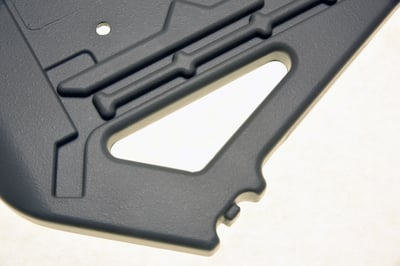Cast vs Injection Molding
When selecting materials for your product or components, understanding the manufacturing process is crucial. While there are various methods, our focus is on cast molding using advanced thermoset polyurethanes, which offers unique advantages for your design decisions.
At MPC, we specialize in providing durable and adaptable solutions through cast molding, enabling you to create complex shapes and precise geometries.
Key Difference Between Cast Molding & Injection Molding
- Material Compatibility: Cast molding is optimized for thermoset polyurethanes, while injection molding typically requires thermoplastics
- Tooling and manufacturing Costs: Cast molding has lower tooling costs compared to injection molding
- Rapid prototyping: Cast molding allows for faster and more cost effective prototyping
Material Compatibility
Cast molding most often employs thermoset materials, which irreversibly shape as they cure, including thermoset polyurethanes. These materials provide significant advantages, including a broader range of durometers, improved abrasion resistance, and enhanced chemical resistance than its thermoplastic cousin, TPU.
In contrast, injection molding typically requires thermoplastics with very low viscosities in their liquid state, like ABS, polypropylene, TPU, and polyethylene, which can limit material operations.
Tooling and Manufacturing Costs

Due to the high pressures and temperature differentials involved in injection molding, tooling costs can sometimes be higher. Tools for injection molding are most often closed metal molds that include complex systems to regulate temperature and material flow. These molds usually require expensive machining and finishing steps. Due to their cost, it may take a long time to amortize the expense of injection molding tools, often requiring very high production volumes.
Cast molding tends to use much simpler mold tooling, and this simplicity usually comes with much lower tooling costs. Cast molding can employ open molds, close molds, compression molds, and many other types of mold designs. This provides a lot of flexibility when designing the right molding process for a product. As a result, cast molding is often a great solution for products with low to high volumes.
Rapid Prototyping
Prototyping products and components in the intended material in a fast and inexpensive way can speed up your product development process; the quicker you can validate the material in the application the quicker you can bring the product to market. The injection molding process requires hard tooling for prototyping, which comes with higher costs and longer lead times. Moreover, if the material does not satisfy the needs of application, you might find yourself with a pricey mold you can not use, or maybe costly to retrofit. The low complexity of cast molding offers the possibility of making prototypes using soft molds made from a variety of materials. Prototype molds for casting can be easily and quickly made, allowing for rapid and iterative prototyping.
A Word About RIM

As a result, this process allows product designers to experiment with various materials, geometries, and features. Moreover, it allows you to validate the molding concept prior to investing in costly production-quality tools. Reaction Injection Molding RIM employs a similar process to injection molding, by introducing material under high pressure into a closed mold. RIM, however, is used in combination with thermoset polyurethanes, allowing for the chemical reaction to occur in the mold cavity. This technology allows product designers to take advantage of a much more robust material set, while also enjoying some of the advantages of injection molding. RIM is most often used for manufacturing larger parts, intricate geometries, or unique surface finishes that may be difficult to obtain from a casting process.
Conclusion
When evaluating different manufacturing methods, it is important to consider the materials requirements for a product, tooling, and production costs, and how the manufacturing process fits into your product development cycle. Injection molding and cast molding both have their own advantages and disadvantages and understanding these manufacturing methods can help a product designer in making material and design decisions. Identifying the right manufacturing process early in the design process can be the difference between an on-time launch and costly delays.
Make Informed Design Choices
Embrace the benefits of cast molding for your next project - Explore our design tool to start your custom molding project today!





